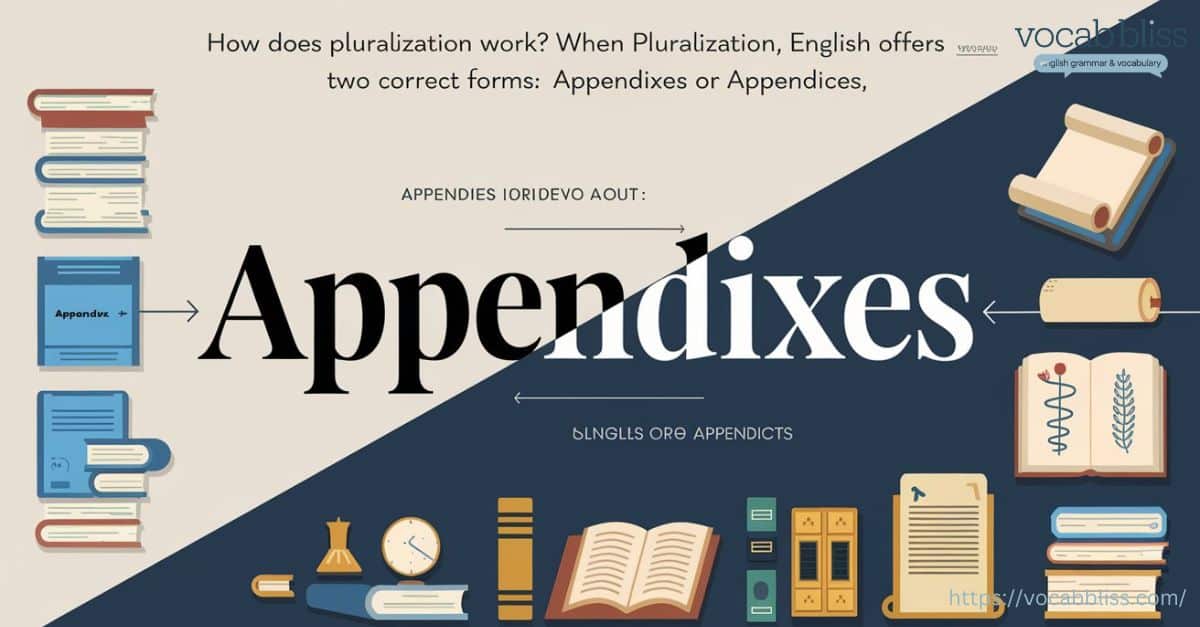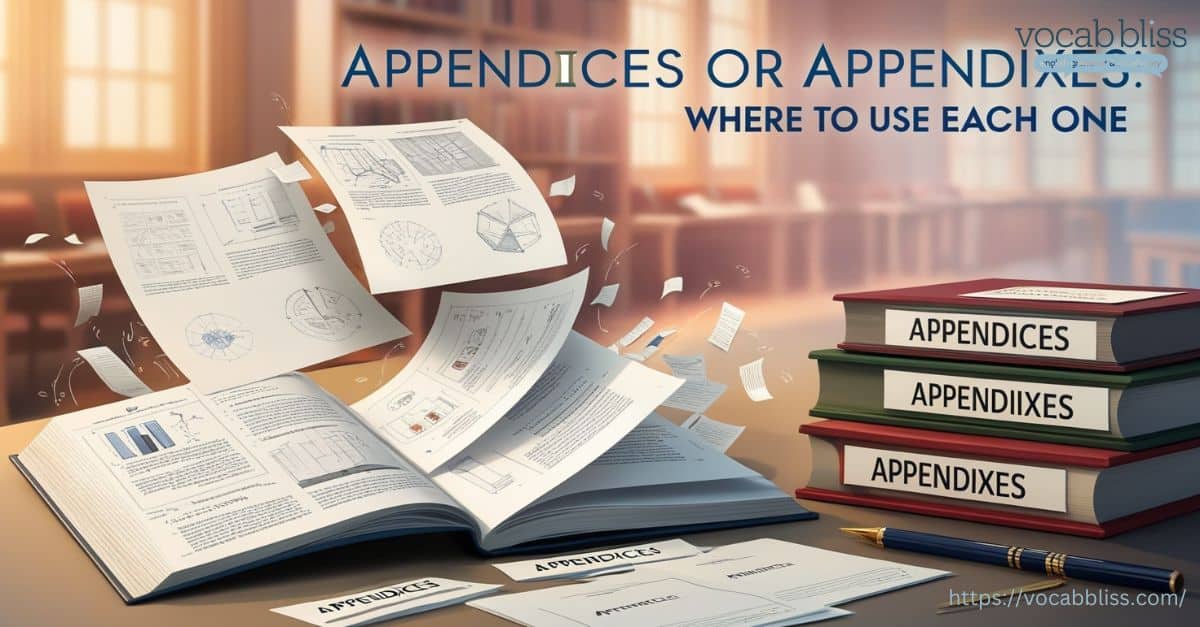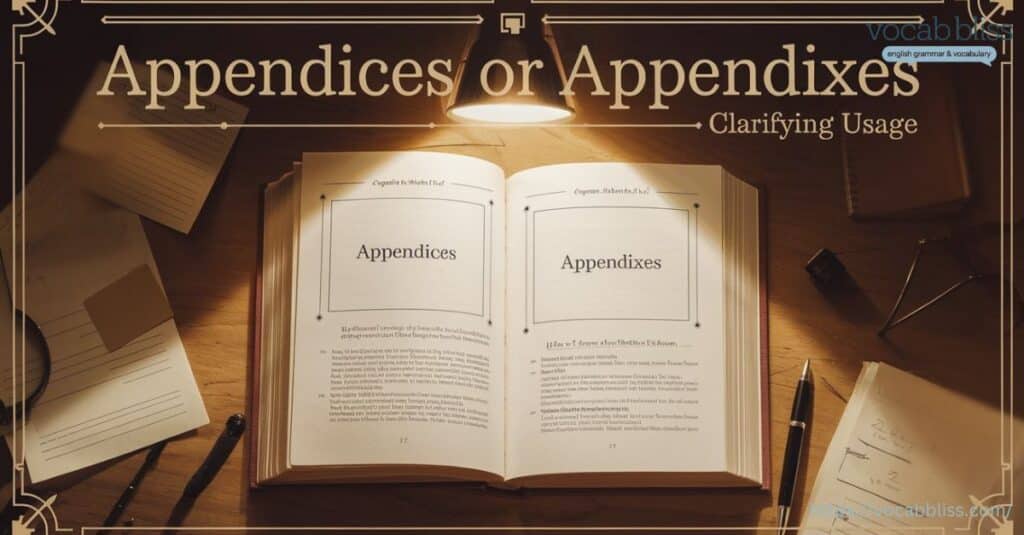If you’ve ever encountered the words appendices or appendixes and wondered which one to use, you’re not alone. These two forms represent a fascinating intersection of language rules, historical influences, and contextual preferences. Let’s dive into their meanings, origins, and practical applications to demystify this linguistic puzzle.
Quick Summary
The words appendices or appendixes are both correct plural forms of the singular term appendix, but their usage depends on context and audience. Appendices is often preferred in formal and academic writing, especially when referring to supplementary sections in books or documents, while appendixes is more common in informal contexts, particularly for anatomical references. The term originates from the Latin word appendere, meaning “to attach,” reflecting its use in both literary and medical fields. Regional preferences and academic style guides, such as APA and MLA, generally favor appendices for formal applications. Understanding the distinctions ensures accurate and effective communication.
What Do “appendixes or appendices” Mean?

The term appendix has multiple meanings, each defined by the context in which it’s used. Despite its versatility, the core idea remains consistent: it represents something supplementary or attached. Let’s explore its two primary contexts—literary and anatomical.
Explore further: Lended or Lent: Which One Fits Best?
The Appendix in Books and Documents
In the realm of writing and publishing, an appendix is a section added at the end of a book, article, or report. Its purpose is to provide additional information that supports or enhances the main content.
Functions of an appendix in writing:
- Supplementary Data: Includes tables, charts, or statistics that are too detailed for the main body.
- References and Resources: Lists citations, documents, or external links for further reading.
- Explanatory Notes: Clarifies complex terms, abbreviations, or concepts mentioned in the text.
For example, in a research paper, an appendix might contain:
- Raw data from experiments.
- Detailed methodology descriptions.
- Additional case studies or transcripts.
In these contexts, the plural is commonly appendices, particularly in formal or academic writing.
The Appendix in Anatomy

In medical terms, the appendix refers to a small, tube-like organ attached to the large intestine, known scientifically as the vermiform appendix due to its worm-like shape.
Functions and characteristics of the anatomical appendix:
- Location: Found in the lower right abdomen, near the junction of the small and large intestines.
- Purpose: Historically thought to be vestigial (without a purpose), newer research suggests it may play a role in gut immunity by hosting beneficial bacteria.
- Medical Relevance: Often associated with appendicitis, an inflammation that can require surgical removal.
When referring to multiple anatomical appendices, both appendices or appendixes are acceptable, though the latter is more common in informal contexts.
Key Distinction Between Textual and Anatomical Appendices
| Aspect | Textual Appendix | Anatomical Appendix |
|---|---|---|
| Purpose | Adds supplementary information to documents. | Plays a potential role in gut immunity. |
| Plural Forms | Appendices (formal), Appendixes (less common). | Appendices (formal), Appendixes (informal). |
| Example Usage | “The appendix contained raw data for analysis.” | “He had his appendix removed after appendicitis.” |
Understanding these contexts helps clarify when to use appendixes or appendices effectively.
Singular Form of “Appendices or Appendixes”
The singular form of both appendixes or appendices is appendix. This versatile word has its roots in Latin, where appendix (meaning “something attached”) was used in contexts ranging from literature to anatomy.
What Does “Appendix” Mean?
The term appendix has two main definitions:
- In Writing and Publishing: An appendix is a supplementary section at the end of a book, article, or report. It provides additional details, resources, or clarifications that enhance the main content. For example:
- “The appendix contained a glossary of terms to help readers understand the technical jargon.”
- In Anatomy: The appendix refers to the small, finger-like organ attached to the large intestine. Though its exact function is debated, it is most commonly known for its association with appendicitis. Example:
- “The surgeon removed the inflamed appendix to prevent complications.”
How Does Pluralization Work?

When pluralizing appendix, English offers two correct forms: appendixes or appendices. The choice depends on context and audience.
Classical (Latin) Pluralization: Appendices
- Derived from the Latin rules of pluralization, where words ending in -ix become -ices.
- Commonly used in formal or academic settings, particularly for textual references.
- Example:
- “The study included three appendices with raw data, charts, and references.”
Modern English Pluralization: Appendixes
- Adheres to standard English rules, adding -es to form the plural.
- More prevalent in casual or informal contexts and often used for anatomical references.
- Example:
- “The doctors studied multiple inflamed appendixes during the medical research.”
When to Use Each Plural Form
| Context | Preferred Plural Form | Explanation |
|---|---|---|
| Academic Writing | Appendices | Retains classical Latin style for a formal tone. |
| Books and Reports | Appendices | Standard in professional publishing. |
| Anatomical References | Appendices or Appendixes | Both are acceptable, but “appendixes” is common. |
| Everyday Use | Appendixes | Easier and more natural in conversational English. |
Key Takeaway
While appendices is often favored in scholarly contexts, appendixes is just as correct and more suitable for informal situations. Understanding this flexibility allows you to tailor your writing for the appropriate audience.
Plural of Appendix
The appendix plural can be either appendices or appendixes, with each form used in different contexts.
- Appendices is more common in formal or academic writing. For instance, in a research paper, you might say:
- “The study included several appendices that provided additional data and references.”
- Appendixes is often used in casual or anatomical references. For example, when talking about the body, you might hear:
- “The surgeon studied multiple inflamed appendixes during the procedure.”
Both forms are grammatically correct, but appendices tends to be the preferred choice in scholarly contexts, while appendixes is more informal.
Origins of the Word “Appendix”
The word appendix has an intriguing history rooted in the Latin language. Its evolution reflects how language adapts to meet the needs of different disciplines, from literature to anatomy.
Etymological Breakdown
- Latin Root: The term appendix comes from the Latin verb appendere, meaning “to hang upon” or “to attach.”
- Ad- means “to” or “toward.”
- Pendere means “to hang.”
- Literal Meaning: In its original sense, an appendix referred to “something that hangs on or is attached to something else.”
In classical Latin, appendix was used to describe supplementary materials or additions. This foundational meaning has remained intact, even as its applications have diversified.
Evolution Across Different Fields
- Linguistics and Literature
- In written works, an appendix became a formal term for additional information added to the end of a document.
- Its purpose is to provide context, evidence, or further explanation without disrupting the main narrative.
- Example: A book might include an appendix containing detailed statistics or explanatory notes for technical terms.
- Anatomy
- The anatomical use of “appendix” emerged in the late Middle Ages when medical studies began naming specific body parts.
- The vermiform appendix (Latin for “worm-shaped appendix”) was identified as a small organ attached to the large intestine.
- Its attachment to the digestive system aligned perfectly with the original Latin sense of “something attached.”
- General Usage in Modern English
- Over time, appendix expanded into broader contexts, from scientific classifications to informal speech.
- The plural forms—appendices (Latin) and appendixes (English)—reflect how the word transitioned from classical origins to modern flexibility.
Timeline of Usage
| Era | Field | Usage of Appendix |
|---|---|---|
| Classical Era | General Writing | Supplementary material added to documents or scrolls. |
| Middle Ages | Medicine | Identified as part of human anatomy (vermiform appendix). |
| Modern Era | Literature, Science | Widely used in academic papers, reports, and anatomy. |
Key Takeaway
The word appendix has maintained its original meaning of “attachment” while adapting to the specialized needs of literature, anatomy, and beyond. Whether you’re referring to supplementary pages in a book or an organ in the human body, its etymological roots underscore the concept of “something that supports or connects.”
Why Are Both “Appendices or Appendixes” Correct Plurals of “Appendix”?
Both forms are valid because English borrows from two systems:
- Classical Pluralization: Retaining Latin endings, hence appendices.
- Modern English Rules: Adding “-es” to create appendixes.
While both forms are correct, context plays a key role. For example:
- Formal Writing or Academic Contexts: “Appendices” is more commonly used.
- Everyday or Informal Use: “Appendixes” might appear more natural.
This duality illustrates how English blends respect for tradition with practical flexibility.
“Appendices or Appendixes”: Where to Use Each One

To choose the correct form, consider the context and audience.
Use Appendices When:
- Writing academic papers, theses, or formal documents.
- Referencing supplementary sections in a book or report.
Example:
- “The research paper included three appendices with detailed tables and graphs.”
Use Appendixes When:
- Speaking informally or writing in conversational English.
- Referring to multiple anatomical appendices.
Example:
- “Several appendixes in the human body can become inflamed, not just the vermiform appendix.”
Pro Tip: Many style guides, including APA and Chicago, favor “appendices” for formal contexts.
Examples of “Appendix Appendices or Appendixes” in Context
Understanding how these words function in sentences clarifies their appropriate use.
Appendix (Singular)
- “The appendix explains the abbreviations used throughout the report.”
- “An inflamed appendix is a medical emergency.”
Appendices (Plural in Reference to Books or Documents)
- “The book includes detailed appendices to support the author’s arguments.”
- “All appendices should be cited within the main text.”
Appendices (Plural in Reference to Anatomy)
- “The study examined cases of multiple appendices in mammals.”
Appendixes (Plural in Informal Contexts)
- “The appendixes in her presentation were clear and concise.”
- “He’s read the appendixes to understand the broader context.”
Frequently Asked Questions
Is one form more correct than the other?
No, both appendices and appendixes are correct plural forms of appendix. However, their appropriateness depends on context:
- Appendices is often preferred in formal or academic writing, such as books, research papers, and technical documents.
- Appendixes is more common in informal contexts or when referring to anatomical structures.
Both forms are grammatically acceptable, so your choice should align with the audience, tone, and subject matter of your writing.
Are there regional preferences between “appendices or appendixes”?
Yes, there are subtle regional tendencies, particularly between British and American English:
- British English: Tends to favor appendices in both formal and informal contexts. This aligns with the traditional preference for Latin-derived plurals in British usage.
- American English: While appendices remains standard in formal writing, appendixes is slightly more common in casual speech and writing, especially for anatomical references.
Despite these tendencies, both forms are understood and acceptable across regions.
Do academic style guides prefer one form?
Yes, most academic style guides recommend appendices for formal writing, particularly when referring to supplementary materials in documents.
Here’s a summary of key style guide preferences:
| Style Guide | Preferred Form | Context |
|---|---|---|
| APA Style | Appendices | Used for sections at the end of academic papers, such as tables or raw data. |
| MLA Handbook | Appendices | Encourages the use of Latin-derived forms in formal writing. |
| Chicago Manual of Style | Appendices | Used in scholarly works and professional publications. |
In academic and professional writing, appendices signals a formal tone and adherence to traditional conventions. Always consult the specific guidelines of your institution or publisher for clarity.
A Final Look at “Appendices or Appendixes”
In conclusion, whether you choose appendices or appendixes depends on your context and audience. Here’s a quick recap:
| Context | Preferred Form |
|---|---|
| Formal writing | Appendices |
| Informal or conversational use | Appendixes |
| Academic papers | Appendices |
| Anatomical references | Appendices / Appendixes |
By understanding the nuances of these terms, you can confidently navigate their usage and avoid common mistakes. When in doubt, consider your audience and aim for consistency within your work.
“Language is the infinite use of finite means.” – Wilhelm von Humboldt
Whether you’re writing a thesis, creating a report, or discussing anatomy, knowing when to use appendices or appendixes ensures your communication remains clear and professional.
Dive Deeper:
- Onsite or On-Site: Examining Fundamental Variations
- Axle or Axel: What’s the Difference?
- in route or en route: Which choice is correct?
- Sueing or Suing? Choose the Right Term

Jorge Phillips is an experienced blogger who writes for Vocab Bliss, sharing his passion for the English language. With a knack for simplifying complex grammar rules and a focus on commonly confused words, Jorge helps readers navigate the nuances of English with ease. His insights aim to make learning engaging and practical.







